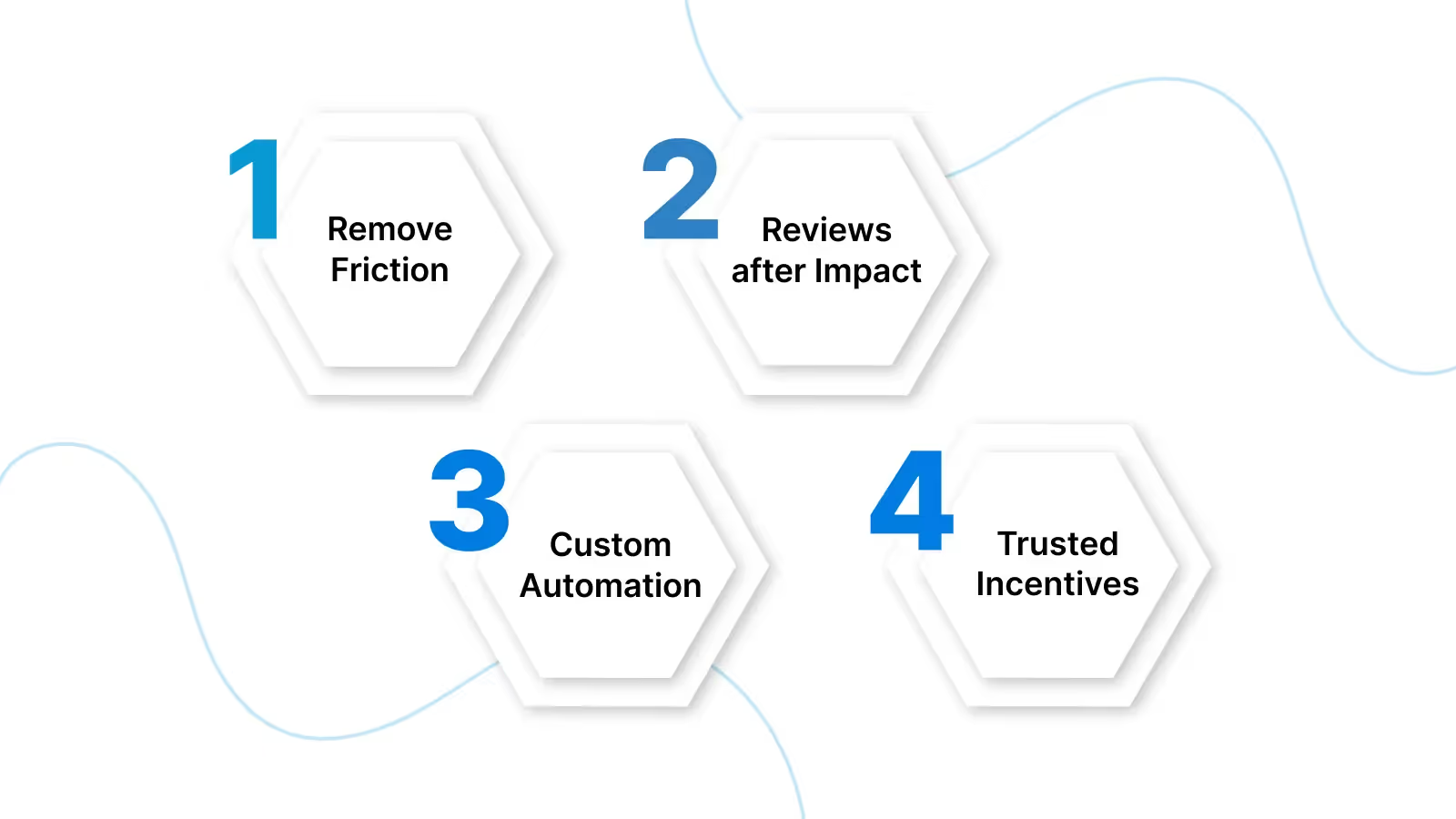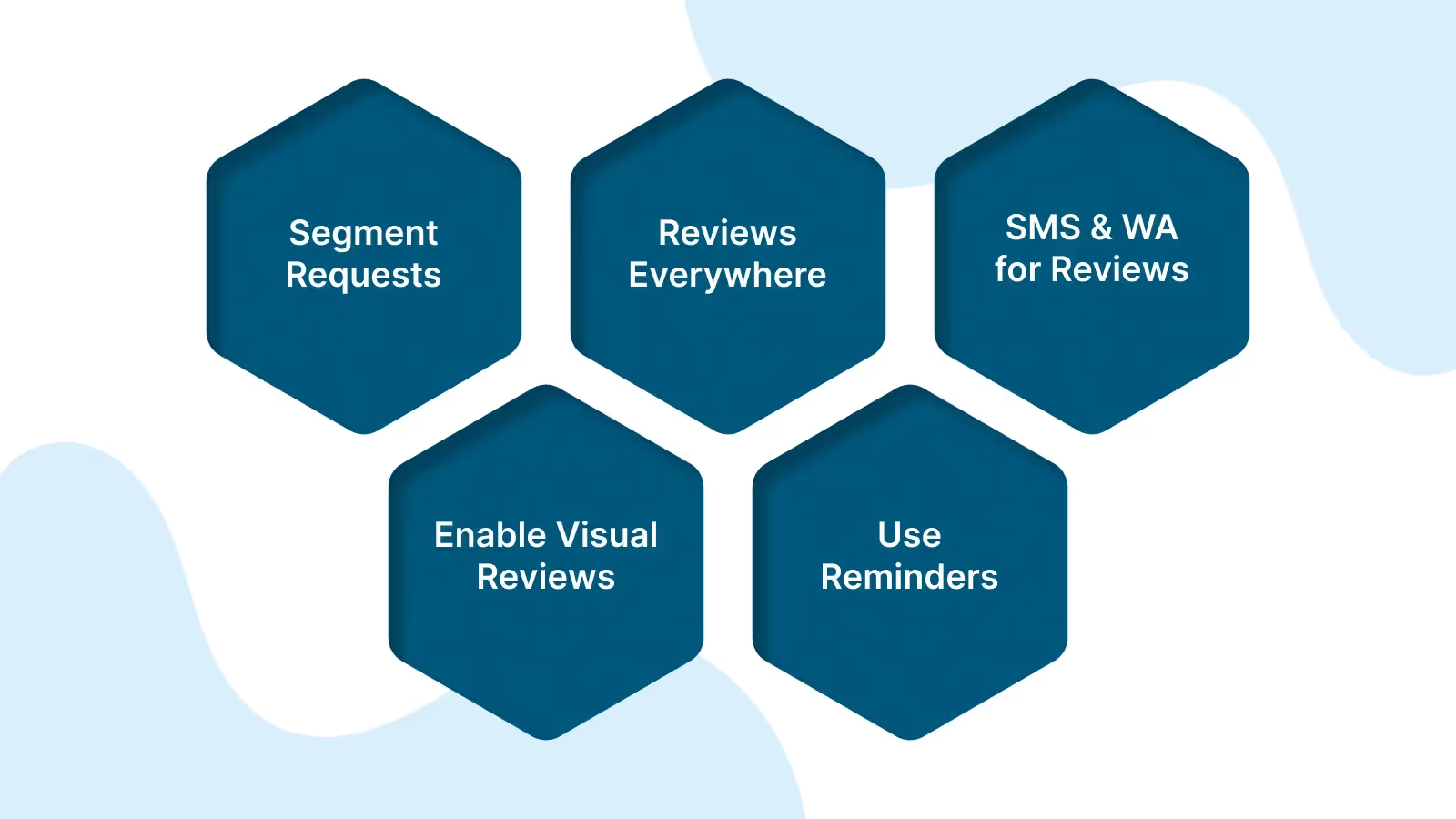.avif)
.avif)
Nearly 90% of people read reviews before visiting a business. But here’s what’s just as important: 88% of consumers say they’re more likely to buy from a company that replies to all its reviews. It’s not just the reviews themselves that matter; it’s how you engage with them.
In today’s marketplace, reviews are more than just digital word-of-mouth. They’re trust signals. They influence perception, guide decisions, and often determine whether a potential customer takes the next step. Yet many businesses still treat them passively, hoping for positive feedback but missing the opportunity to shape the conversation.
This blog explores how to build a review strategy that does more than just collect stars. We’ll cover practical ways to encourage authentic reviews, respond to feedback (good and bad), and use this ongoing dialogue to strengthen brand credibility, build loyalty, and even improve your bottom line.
What Are Customer Reviews?
Customer reviews are firsthand accounts shared by people who have used your product, service, or interacted with your brand. These are typically posted on third-party sites, your platform, or across social media. Reviews serve as public records of satisfaction, providing future customers with relatable and trusted insights.
For your business, reviews are more than feedback. They reveal how well you meet expectations and where you need to improve. Unlike marketing messages, reviews feel authentic and hold more influence because they are based on real experiences.
When prospects see genuine, consistent feedback, they gain the confidence to move forward. At the same time, you gain a clearer understanding of your strengths and areas for improvement. Each review, whether positive or negative, presents an opportunity to adjust, grow, and reinforce your credibility. In a world where peer validation drives decisions, reviews serve as both trust signals and strategic differentiators, influencing decisions and shaping perceptions.
Understanding what reviews are sets the foundation for effective review management. But to use them strategically, you need to grasp their actual impact.
Read: Unleash Your Shopify Store's Potential with These Top 10 Reviews Apps
Why Customer Reviews Matter
Customer reviews are one of the most powerful trust signals in the buying journey. Today’s consumers don’t just stumble upon reviews; they actively seek them out. In fact, 79% spend the most time reading Google-based reviews, and over 30% check reviews regularly, either monthly or several times a year.
These reviews do more than validate a purchase; they shape first impressions, influence conversions, and impact how your business ranks in search results. They’re also a reflection of how engaged your brand is: 88% of consumers say they’re more likely to buy from a company that responds to all its reviews.
When managed well, reviews become more than feedback—they become a strategic asset that builds credibility, encourages repeat business, and deepens customer relationships over time.
1. Strengthen Trust and Boost Purchase Confidence
When prospective buyers read authentic feedback, they form quick opinions about your reliability. Research shows that 76% of consumers trust online reviews as much as personal recommendations. That trust can determine whether someone moves forward with a purchase or walks away.
Placing relevant reviews near your product or checkout pages helps reduce uncertainty. When visitors see others validating their decision, they are more likely to act. This credibility leads to higher conversion rates and smoother purchase journeys. For a deeper understanding of why reviews matter, explore this guide on how they shape trust and SEO performance.
2. Improve Search Visibility With Real Customer Language
Search engines prioritize content that mirrors how users speak. Reviews often contain long-tail keywords and informal phrases like "fast resolution" or "affordable option"; terms that match real-world search intent.
Consistent review activity generates fresh, keyword-rich content that improves indexing. It also signals to search engines that your brand is relevant and actively engaged, enhancing your SEO performance over time.
3. Use Feedback to Spot Gaps and Drive Improvements
Reviews offer unfiltered insights into customer satisfaction. Over time, you will notice repeated patterns that highlight what you are doing well and where you're falling short. For instance, if many reviews flag delayed support, it becomes a measurable area to address.
Acting on this feedback helps reduce churn and improve satisfaction. With 86% of customers avoiding businesses with negative reviews, addressing gaps is a direct investment in long-term trust and retention.
4. Respond Thoughtfully to Build Accountability and Loyalty
Responding to reviews, especially critical ones, shows that you value input and take responsibility. This builds transparency, which in turn fosters loyalty. 53% of customers expect businesses to respond to negative reviews within a week.
You don't need to reply to every comment, but consistently engaging with purpose matters. A concise, respectful response can turn dissatisfaction into trust. Acknowledging praise also shows gratitude and reinforces a positive brand experience.
Now that you understand why customer reviews matter, the next step is knowing how to generate them actively. Start with a few proven, foundational strategies that create a steady flow of feedback without overwhelming your team.
Read: The Art of Responding to Reviews: Best Practices for Building Customer Loyalty
Essential Review Strategies to Build a Reliable Feedback Engine

To build a consistent stream of high-quality customer reviews, your customer reviews strategy must align with how users interact with your brand. These foundational practices are tailored for growth-focused D2C and subscription-based companies aiming to convert more visitors and improve lifetime value.
1. Remove Friction From the Review Process
Simplify every touchpoint. Include direct review links in:
- Post-purchase emails
- Order confirmation pages
- WhatsApp or SMS updates
- In-app notifications (for mobile-first users)
For physical locations, use printed QR codes on packaging or receipts. Fewer clicks mean higher review completion rates.
Tip: Pre-fill fields or guide users with prompts to reduce decision fatigue.
2. Ask for Reviews When Value Has Been Delivered
Do not wait too long. Trigger review requests based on clear customer milestones:
- Immediately after a product is delivered.
- After a support ticket is resolved with a 5-star rating.
- Once a user completes an onboarding tutorial or logs their 5th session.
This ensures the experience remains top-of-mind and emotions remain positive. Here are 5 proven ways to encourage more reviews without overwhelming your customers.
3. Automate With Personalization
Utilize your CRM or email automation to send timely and relevant requests. But avoid generic messaging.
- Use customer names and order details.
- Reference the specific product or feature they engaged with.
- Test subject lines and send times to improve open rates.
Personalization helps reduce opt-outs and boosts review volume, reinforcing the effectiveness of your customer reviews strategy.
4. Offer Incentives Without Undermining Trust
Incentives work, but clarity is critical. Offer:
- Discount codes for future purchases.
- Loyalty points added to their next cycle.
- Early access to upcoming products.
Always disclose the incentive, and never pressure for positive feedback. With Nector, you can automate review collection while maintaining a transparent and compliant process. The platform enables you to gather authentic, high-quality feedback at scale without adding operational complexity.
Once you have these building blocks in place, you can scale with advanced review generation tactics designed to fuel long-term growth and loyalty.
Also Read: 9 Successful Loyalty Program Examples to learn from in 2025.

Scalable Methods to Grow Your Review Numbers

Once the basics are in place, it’s time to evolve your customer reviews strategy with advanced tactics that scale results. You need to implement targeted strategies that increase participation, capture diverse review formats, and embed customer feedback into every key stage of your customer journey. These tactics not only drive higher review volume but also amplify brand credibility across all channels.
1. Segment Requests by Customer Type and Purchase Stage
Use behavioral data to create distinct review outreach campaigns:
- First-Time Buyers: Ask about the onboarding or unboxing experience.
- Repeat Customers: Dive into satisfaction, consistency, and loyalty drivers.
- High-Value Shoppers: Use personalized outreach and invite them into deeper engagement loops.
With Nector, this segmentation happens automatically. You can filter users by purchase frequency, order value, and engagement history, then trigger tailored review prompts that actually resonate. No mass emails. No one-size-fits-all templates. Just smart, contextual outreach that boosts both review volume and relevance.
2. Enable Visual Reviews to Build Deeper Trust
Encourage users to submit photos or videos of their purchase in real-world settings. These:
- Validate product quality visually.
- Provide scalable social proof.
- Enhance retention by reusing in remarketing campaigns.
Product pages showcasing customer photos and videos can boost conversion rates by up to 90%. Visual UGC builds stronger brand credibility than text alone, especially in fashion, beauty, and lifestyle segments.
Read: Beyond Points and Tiers: How UGC Can Revolutionize Your Ecommerce Loyalty Program
3. Integrate Reviews Across All Customer Touchpoints
Visibility amplifies impact. Display reviews:
- On high-traffic products and landing pages.
- In post-purchase emails and retargeting ads.
- Within onboarding workflows or loyalty dashboards.
This multi-channel approach creates repetition, which builds recall and trust.
4. Use Reminder Workflows Intelligently
If a customer doesn’t respond, trigger a gentle reminder after 2–5 days.
Best practices:
- Limit reminders to one or two follow-ups.
- Include value-oriented messaging ("Your feedback helps us improve").
- Add visual elements to draw attention without causing fatigue.
Avoid repeated outreach to unresponsive users. Let your system prioritize those with higher open and click rates.
5. Drive Reviews via High-Conversion Channels like SMS and WhatsApp
D2C customers engage faster on direct messaging platforms. Review links shared via SMS or WhatsApp have significantly higher click-through rates than email.
- Keep messages short (under 160 characters).
- Personalize with first name and product details.
- Link directly to your review page, powered by tools like Nector.io.
Combined, these tactics give you the structure and scalability to make reviews a continuous part of your review strategy, not just a post-purchase afterthought. But even with a strong system in place, how you respond to critical feedback can shape long-term perceptions. That brings us to an equally important focus: handling negative reviews strategically.
Also Read: How to Build a Referral Incentive Program in 2025.
Handling Negative Reviews Strategically

Negative reviews are unavoidable, but how you respond determines how much value they create. For D2C brands and digital-first businesses, every review, positive or critical, is a touchpoint that influences perception, retention, and future conversions.
1. Respond Promptly, Personally, and Professionally
Timeliness matters. Respond to negative reviews within 24 to 48 hours. Personalize each response using the customer’s name and product details. Avoid templates that sound robotic. Learn the best practices for responding to reviews that foster trust and improve brand loyalty.
Example: “Hi Ananya, thank you for sharing your feedback about the Rosewood Serum. We’re sorry it didn’t meet your expectations. Our team is already looking into the issue and will follow up directly.”
This approach demonstrates that your brand listens and takes responsibility.
2. Tag, Track, and Act on Feedback
With Nector, you can move beyond reactive fixes. Create workflows that tag incoming feedback based on keywords, sentiment, or recurring product-level issues. Use this data to build dashboards segmented by:
- Product line or SKU.
- Support type (shipping, quality, response time).
- Region or fulfilment partner.
Route these insights directly into your internal feedback loops. Integrate with your product, CX, or logistics teams to close the loop faster and with clear ownership.
3. Balance Visibility With Resolution Depth
Not every issue should be solved in the comment thread. Acknowledge negative feedback publicly, then shift to a direct channel. For example:
- Public: "Thanks for bringing this to our attention. We're reviewing your case now."
- Private: Share a WhatsApp link or open a support ticket for resolution.
This reinforces that your brand is transparent but also respects the customer’s privacy.
4. Turn Resolved Issues Into Proof Points
Once you’ve closed the loop, use those stories strategically. Examples:
- Create anonymized screenshots or blurbs for carousel posts.
- Insert resolution snippets in customer onboarding emails.
- Build a section on your site titled "Customer Concerns We've Fixed."
Recovery narratives signal operational maturity. They also attract users who value brands that take responsibility and act decisively. Beyond individual platforms, there's also value in ensuring your best reviews reach a wider audience. This is where cross-platform syndication becomes essential.
Also Read: A Practical Guide to Effective Customer Retention Management.
Cross-Platform Syndication and Compliance
To fully capitalize on customer reviews, you need to do more than collect them; you must scale their impact while adhering to platform and legal standards. For growth-stage brands and subscription-based platforms, syndication and compliance are key levers for brand visibility and trust.
Expand Reach With Multi-Channel Distribution
Push high-impact reviews to:
- Google Merchant Center for search visibility and product trust signals.
- Meta and Instagram Shops to improve in-app purchase conversions.
- Marketplace listings, such as Amazon, Flipkart, or niche category-specific platforms.
Consistency across these ecosystems strengthens SEO, builds platform-specific credibility, and supports cross-channel attribution. With Nector, you can automate this distribution through integrations and APIs, reducing manual overhead and maintaining data integrity.
Integrate Reviews Seamlessly On-Site
Leverage widgets or embedded modules to showcase live reviews on:
- Homepage banners.
- Product detail pages.
- Checkout pages (to reduce drop-off).
Dynamic review modules keep content fresh and reduce bounce rates by validating credibility at critical decision points.

Prioritize Regulatory and Platform Compliance
Non-compliance undermines trust and invites penalties. Build safeguards into your review workflows:
- Incentive Disclosure: Mark reviews obtained via loyalty rewards or discounts.
- Policy Alignment: Comply with platform-specific rules to avoid suppression or flagging.
- Audit Trails: Maintain logs of when and how reviews were collected for internal transparency and accountability.
Done correctly, review syndication becomes more than amplification; it becomes an enabler of performance marketing, platform retention, and brand integrity. To ensure these efforts translate into measurable business outcomes, it’s important to track impact systematically, which leads us to measuring success and ROI.
Measuring Success and ROI
To ensure your review strategy delivers tangible results, track performance using specific, actionable metrics that align with your growth goals. This data informs continuous improvement across marketing, product, and customer support, helping teams refine messaging, enhance experiences, and prioritize development based on real customer input.
Key Metrics to Monitor
- Review Generation Rate: Track the number of new reviews per product, category, or campaign. Set benchmarks by channel (e.g., email, WhatsApp, QR codes) to identify what drives the highest yield.
- Sentiment Distribution: Categorize reviews into positive, neutral, and negative segments. Utilize sentiment scoring to evaluate brand health over time and identify sentiment shifts following product launches or service updates.
- Conversion Attribution: Measure how review exposure influences behavior:
- Uplift in cart conversions after reading product reviews.
- Higher engagement on pages featuring visual UGC.
- Impact on the returning user rate.
Use GA4 for behavioral tracking and Nector native analytics to correlate review activity with business outcomes. Combine these with heatmaps and session replays to observe how reviews affect buyer flow.
Also Read: A Complete Guide to Customer Advocacy: Drive Loyalty and Brand Success.
Your Review Strategy in Action
Customer reviews are crucial for establishing trust, enhancing experiences, and driving growth. But to realize their full potential, you need a system that makes review collection scalable, actionable, and consistently valuable across all customer touchpoints.
Nector helps you operationalize this vision. From automated review requests to multi-channel distribution and real-time analytics, our platform turns customer feedback into a structured growth engine. You stay in control while your customers do the talking.
Start transforming your customer reviews strategy into measurable outcomes that build long-term trust and growth. Book a demo today to see how Nector.io can support your growth.
FAQs
How can I ensure the authenticity of reviews and prevent fake submissions?
Use verification systems such as post-purchase review triggers, email confirmation links, and platform-based filters to validate reviews. Integrating reviews directly with your order management system helps ensure only actual customers can leave feedback.
What is the ideal review-to-sale ratio for a healthy feedback loop?
While this varies by industry, a common benchmark is 5–10% of buyers leaving reviews. If you're falling short, revisit your timing, messaging, and placement of review requests to remove friction.
Should I localize customer reviews for different markets?
Yes. Localized reviews (in regional languages or country-specific experiences) improve relevance and trust in multi-market environments. Display location-specific reviews dynamically using geo-IP or customer profile data.
How do I track the lifetime value (LTV) impact of highly engaged reviewers?
Tag and segment repeat reviewers in your CRM. Cross-reference their behaviour with your LTV metrics to measure if engaged reviewers buy more frequently, refer others, or require fewer support touchpoints.
Can I use reviews to identify potential brand advocates?
Absolutely. Monitor for repeat positive reviewers and customers who leave detailed, enthusiastic feedback. These individuals are strong candidates for referral programs, loyalty tiers, or early-access product testing.
Start Building Customer Retention That Lasts





.avif)

.avif)

